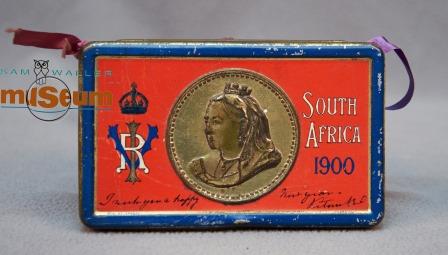The Second African War or Second Boer War was fought between 1899 and 1902, and was between the United Kingdom and Ireland (which included Canada, as part of the British Empire) against the South African Republic and Orange Free State. The United Kingdom and Ireland were eventually victorious. It was the first war that saw Canadians being sent overseas to fight. Broadly speaking, French-Canadians and new immigrants did not believe that Canada should help England fight this war halfway around the world, and the government of the time promised that fighting overseas for England would not be a precedent, something that the next hundred years would prove to be a lie. More than 7, 000 Canadian volunteers, including 12 women in the role of nurses, served in the Second Boer War, and 267 Canadian men were killed.
This tin was given out by Queen Victoria to all of her soldiers in celebration of New Year’s, 1900. On the top of the box, under her portrait, are the words “I wish you a happy New Year, Victoria Reg.” [Reg. most likely representing Regina, Latin for Queen]. Many soldiers appear to have kept theirs until the end of the war as a keepsake. Some even sent theirs home during the war to keep it safe, sometimes never to follow their boxes home. Indeed, sometimes after a soldier was killed in battle, their comrades would send whatever personal effects they could fit into the fallen soldier’s chocolate tin. It appears that ours was hung up for display for many years. The evidence for this comes from the purple ribbon that is tucked inside by the lid. Part of the ribbon is much lighter than the other – this is evidence of light damage, which happens over time. Fabrics are particularly susceptible to light damage.
Queen Victoria commissioned Cadbury to create the tins, but the owners of Cadbury were Quakers, a group who are pacifists. So as not to refuse a commission from the Queen but also to prevent any accusations of supporting the war, the Cadbury owners invited two other prominent Quaker chocolate companies to join them, J. S. Fry and Rowntree. The companies did not want to put their logos onto the chocolate tins, but the Queen wanted to show that she was purchasing quality chocolate for her soldiers. They stamped their names on the chocolate bars. Each of the three chocolate companies had a different company produce their tins. Ours is a Rowntree tin, which is identifiable because of its size, the slant of Queen Victoria’s writing, the placement of her bust within the medallion, and the clean dots circling the medallion. Rowntree was bought by Nestle in the 1980s. Fry’s merged with Cadbury in 1919, which was in turn purchased by Kraft in 2010.
It is unclear who was the original owner of this tin.


